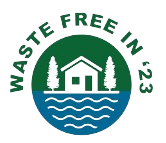WF23 SL Training Plastic Recycling Introduction

WASTE FREE PLASTICS RECYCLING INTRODUCTION - Mrs. GBESSAY ALLIEU FRIDAY’S FOR FUTURE-SIERRA LEONE
PLASTIC RECYCLING: is the processing of plastic waste into other products.Recycling can reduce dependence on landfill, conserve resources and protect the environment from plastic pollution and greenhouse gas emissions.Recycling rates lag those of other recoverable materials, such as aluminium, glass and paper. Through 2015, the world produced some 6.3 billion tonnes of plastic waste, only 9% of which has been recycled, and only ~1% has been recycled more than once.Additionally, 12% was incinerated and the remaining 79% sent to landfill or to the environment including the ocean.
Almost all plastic is not biodegradable and absent recycling, spreads across the environment where it can cause harm. For example, as of 2015 approximately 8 million tons of waste plastic enter the oceans annually, damaging the ecosystem and forming ocean garbage patches.Even the highest quality recycling processes lead to substantial plastic waste during the sorting and cleaning process, releasing large amounts of microplastics in wastewater, and dust from the process.
Almost all recycling is mechanical: melting and reforming plastic into other items. This can cause polymer degradation at a molecular level, and requires that waste be sorted by color and polymer type before processing, which is complicated and expensive. Errors can lead to material with inconsistent properties, rendering it unappealing to industry.In feedstock recycling, waste plastic is converted into its starting chemicals, which can then become fresh plastic. This involves higher energy and capital costs. Alternatively, plastic can be burned in place of fossil fuels, in energy recovery facilities or biochemically converted into other useful chemicals for industry. In some countries, burning is the dominant form of plastic waste disposal, particularly where landfill diversion policies are in place.
Plastic recycling is low in the waste hierarchy. It has been advocated since the early 1970s,but due to economic and technical challenges, did not impact plastic waste to any significant extent until the late 1980s. The plastics industry has been criticized for lobbying for expansion of recycling programs, even while research showed that most plastic could not be economically recycled.

Collecting and sorting
Bales of color sorted PET bottles (blues, clear and greens) Olomouc, the Czech Republic.
Manual separation of co-mingled waste (2 min).
Recycling begins with the collection and sorting of waste. Curbside collection operates in many countries. Waste is sent to a materials recovery facility or MBT plant where the plastic is separated, cleaned and sorted for sale. Unsuitable materials are sent to a landfill or incinerator. These operations account for a large proportion of the financial and energy costs associated with recycling.
Sorting plastic is more complicated than other recyclable materials because it comes in a greater range of forms. For example, glass is separated into three streams (clear, green and amber), metals are usually either steel or aluminum and can be separated using magnets or eddy current separators, and paper is usually sorted into a single stream.
Six types of commodity polymer account for about 75% of plastics waste, with the rest comprising a myriad of polymer types, including polyurethanes and synthetic fibers with a range of chemical structures. Items made from the same type of polymer may be incompatible with each other depending on the additives they contain. Additives are compounds blended into plastics to enhance performance and include stabilizers, fillers and, most significantly, dyes.Clear plastics hold the highest value as they may be dyed after recycling, while black or strongly coloured plastic is much less valuable, because they affect the color of the downstream product. Thus, plastic is typically sorted by both polymer type and color.
Various sorting approaches and technologies have been developed. They can be combined in various ways.In practice no approach is 100% effective.Sorting accuracy varies between recyclers, producing a market where products are poorly standardized. This inconsistency is another barrier to recycling.
Manual separation
Sorting by hand is the oldest and simplest method. In developing countries this may be done by waste pickers, while in a recycling center, workers pick items off a conveyor-belt. It requires low levels of technology and investment, but has high labor costs. Although many plastic items have identification codes, workers rarely have time to look for them, leaving problems of inefficiency and inconsistency. Even advanced facilities retain manual pickers to troubleshoot and correct sorting errors.Working conditions can be unsanitary.
Density separation
Plastic Type | Density (g/cm3) |
Polyvinyl chloride | 1.38-1.41 |
Polyethylene terephthalate | 1.38-1.41 |
Polystyrene | 1.04-1.08 |
High-density polyethylene | 0.94-0.98 |
Low-density polyethylene | 0.89–0.93 |
Polypropylene | 0.85-0.92 |
Polystyrene foam | 0.01-0.04 |
Plastics can be separated by exploiting differences in their densities. In this approach the plastic is first ground into flakes of a similar size, washed and subjected to gravity separation.This can be achieved using either an air classifier or hydrocyclone, or via wet float-sink method. These approaches provide partial sorting, as some polymers have similar density. Polypropylene (PP) and polyethylene (PE) are similar as are polyethylene terephthalate (PET), polystyrene (PS), and PVC. In addition, if the plastic contains fillers, this may affect its density.The lighter PP and PE fraction is known as mixed polyolefin (MPO) and can be sold as a low-value product,the heavier mixed plastics fraction is usually unrecyclable.
Electrostatic separation
Main article: electrostatic separator
In electrostatic separators, the triboelectric effect is used to charge plastic particles electrically; with different polymers charged to different extents. They are then blown through an electric field, which deflects them depending on their charge, directing them into appropriate collectors. As with density separation, the particles need to be dry, be uniform in size and shape. Electrostatic separation can be complementary to density separation, allowing full separation of polymers,albeit of mixed colors.
If you have any questions, contact:
- www.wastefree23.org
- https://www.facebook.com/groups/1257683511822828
- Wastefree23@gmail.com
- Whatsapp +14084620209
